
First things first, for anyone who is not familiar with the recipe, Lanzhou beef noodle soup or Lanzhou La Mian (兰州拉面), is a popular Chinese dish that originated in Lanzhou, the capital city of Gansu province in northwestern China. This soup is known for its simplicity, but I would say it relies on simmering and careful seasoning to highlight its natural flavor.
I want to point out that one of the defining features of Lanzhou beef noodle soup is the hand pulled noodles. They are usually made fresh by a chef, who stretches and folds the dough until it becomes long, thin, and even strands. Watching this in a Lanzhou style shop is an experience worth seeking out when you travel in China. Or you can simply learn to make my easy hand-pulled noodles from scratch, and I always recommend it for this soup.
Now let us talk about the broth. My homemade broth uses beef and beef bones simmered with spices and aromatics for hours until it becomes deeply savory and hearty. Then comes the fun part, the assembly, which is surprisingly simple. I serve the noodles in the clear broth and add tender pieces of beef, radish, cilantro, and a spoon of my homemade chili oil. My recipe makes about 8 servings, yet if you have a small family like mine, it stores well and is great to enjoy later.
Unlocking Lanzhou beef noodles at home
In China, the true Lanzhou beef noodle recipe is closely guarded. Each noodle shop protects its own version, which makes the authentic flavor challenging to recreate at home. But I have good news, when you choose the right ingredients, you can create a bowl that comes very close to the traditional version in your own kitchen. That is exactly what I share in my step by step directions for making the most delicious Lanzhou beef noodle soup, which has become one of my favorite Chinese soup recipes.
Ingredients
These are the ingredients I use to make this Lanzhou beef noodle soup. I also share a few substitutions I have tested that work well for this recipe.
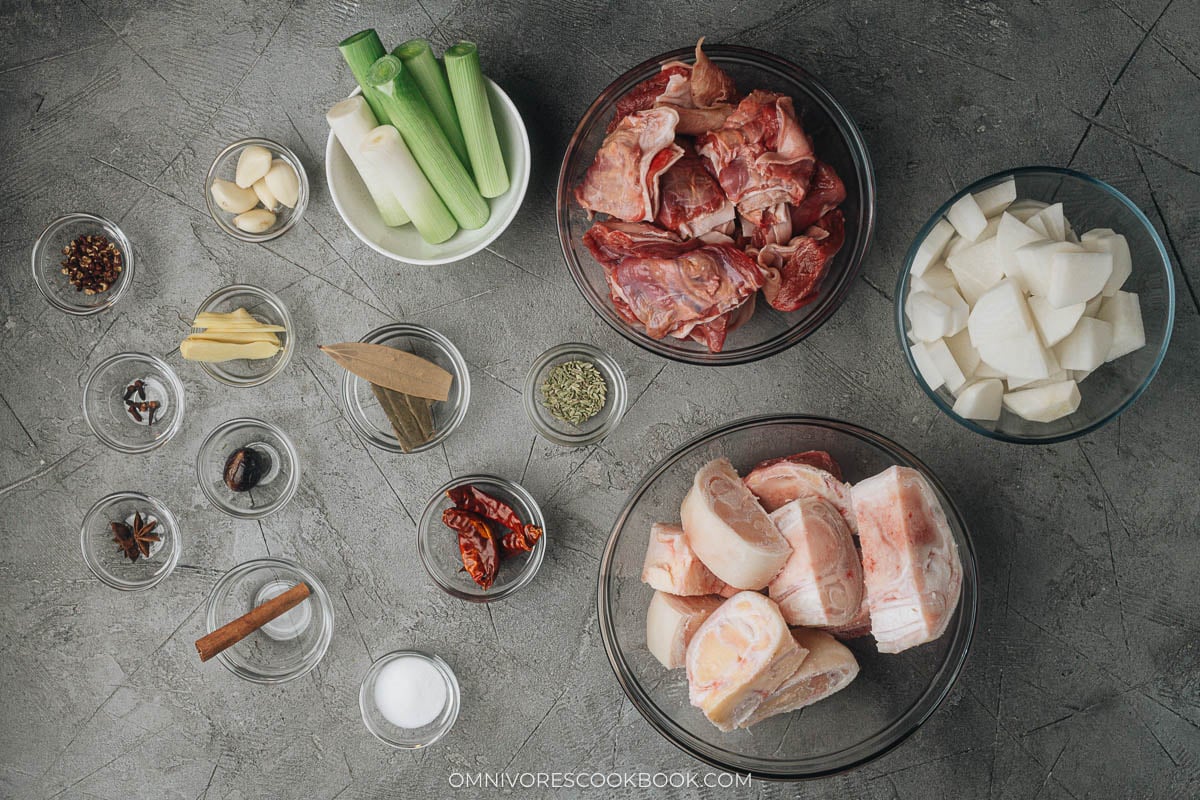
Beef and bones for the broth
For the beef, my first choice is untrimmed flank steak. In Chinese it is called Niu Nan (牛腩) and the cut is quite different from what you usually see in regular grocery stores in the United States, so I usually pick it up at a Chinese market. It has more fat and membranes, and I love how they melt during cooking and keep the beef tender and juicy. If you cannot find this cut, brisket, round roast, or chuck also work very well.
When it comes to the bones, I usually choose beef shin ones for this soup. Neck bones are a good alternative if that is what you can get.
Aromatic Spice Soup Base
Aromatics: I use ginger, garlic, and scallion to build the foundation of the broth.
Spices: I add chili pepper, bay leaves, fennel seeds, nutmeg, cinnamon, star anise, whole cloves, and Sichuan peppercorns. This mix gives the broth its depth and the warm fragrance that Lanzhou noodles are known for.
Salt and daikon radish: I season the broth with salt and simmer daikon radish until it turns tender. The radish adds a mild sweetness that balances the beef and spices.
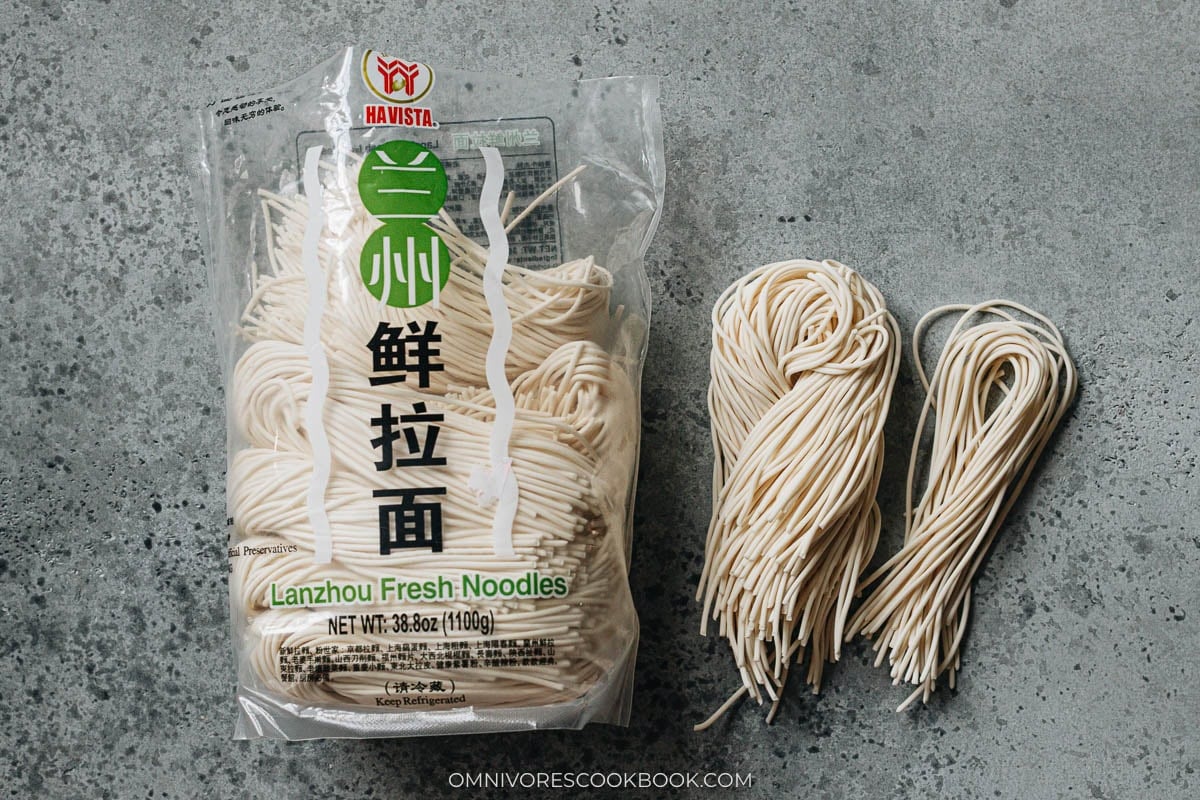
Key ingredient: hand-pulled noodles
As I mentioned earlier, the closest way to enjoy an authentic bowl is to make your own hand pulled noodles. I have a hand pulled noodle recipe that you can follow at home. It takes some time and patience, but it is very doable when you follow my steps, and the results are always worth it.
When I am not making noodles from scratch, I look for Lanzhou fresh noodles by Havista at my local Asian market. These semi dried noodles turn nicely chewy once boiled, and they work great in this soup. If you can’t find them, dried wheat noodles are a great option, and a spaghetti style shape comes closest to the traditional look.
How to make
1. Start the broth: Add the beef bones and meat to a large pot and cover them with 8 cups of cold water. Heat the pot over medium high until it comes to a boil, stirring a few times to keep the meat from sticking. Once the water reaches a boil, reduce the heat to medium.
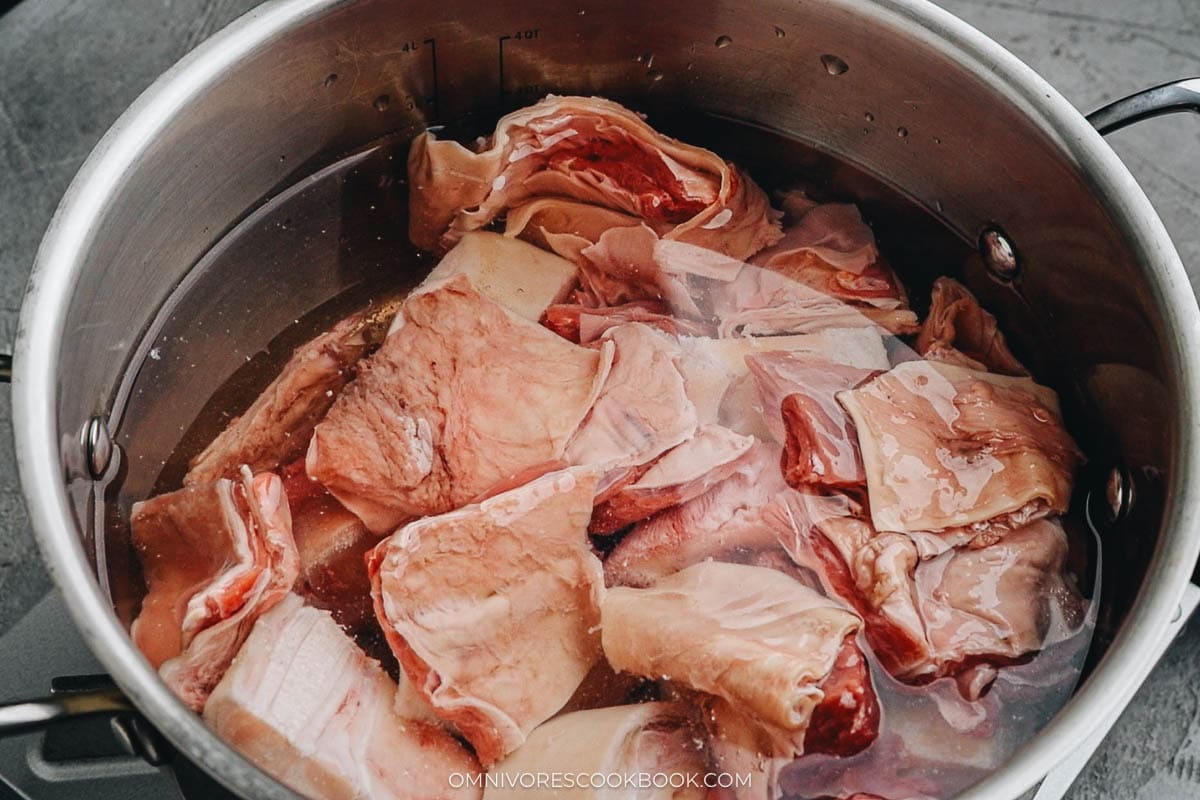
2. Skim the broth: Skim off the brown foam from the surface and discard it. Continue skimming until the broth looks almost clear, which usually takes me about 10 minutes.

3. Add spices and aromatics: Transfer the beef, bones, and broth into an Instant Pot, then add the spices and aromatics.
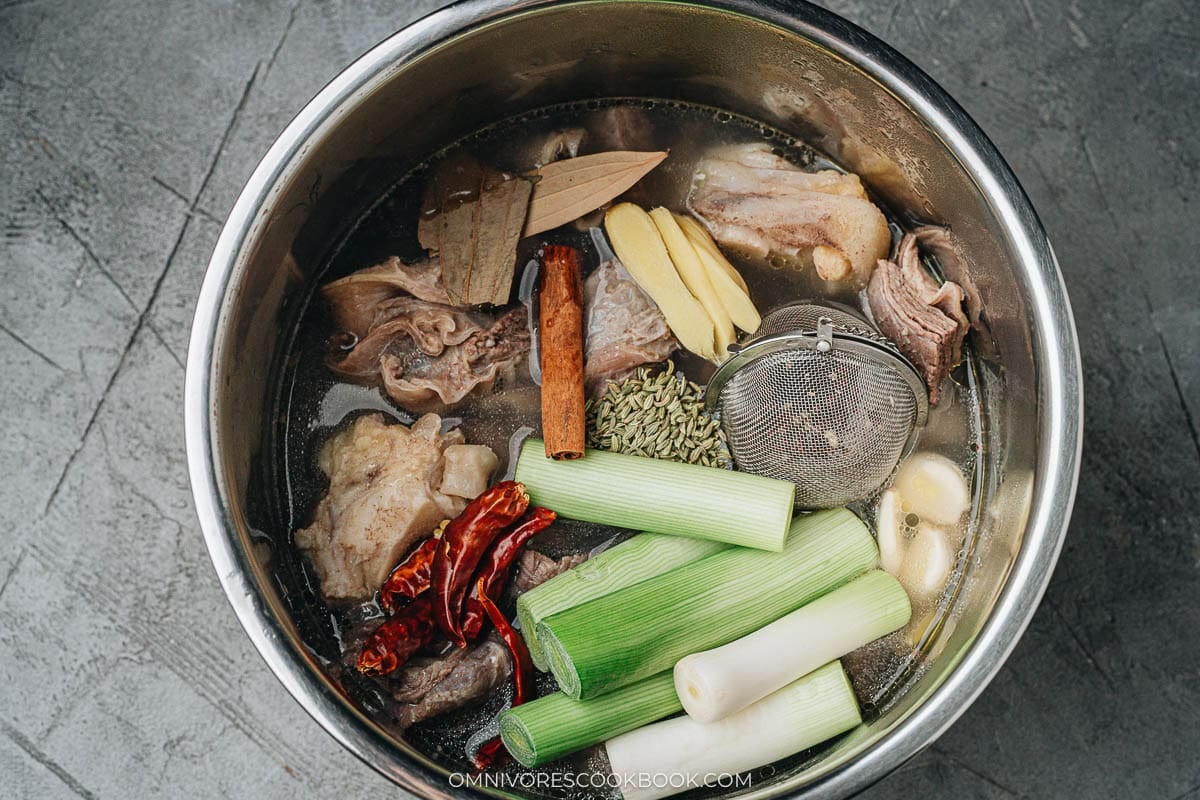
4. Pressure cook the broth: Cook on high pressure for 1 hour, until the beef turns tender and the broth becomes rich.
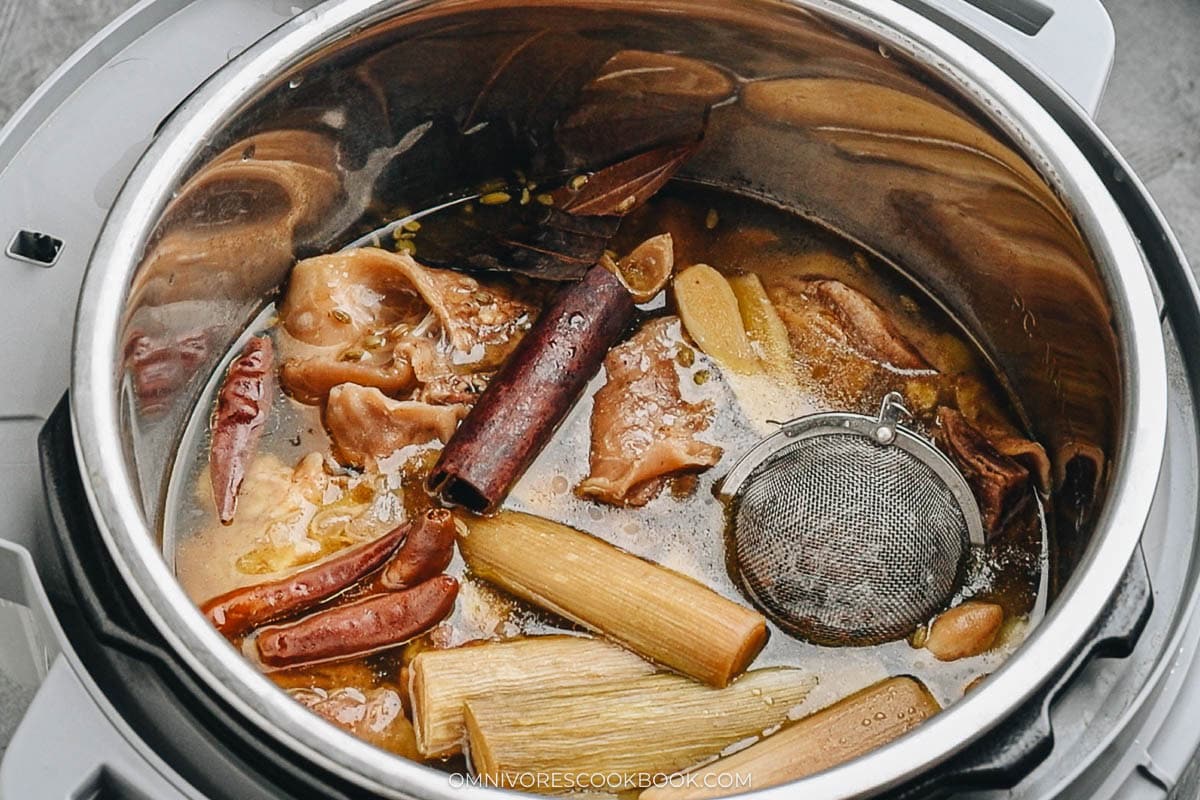
5. Remove the solids: Transfer the beef pieces onto a plate, then discard the bones and the spices.

6. Cook the radishes: Add the radishes to the broth and simmer for around 10 minutes until they turn tender.

7. Cook and assemble the noodles: Boil the noodles according to the package instructions, then divide them among the bowls. Pour the hot broth over the noodles and add a few pieces of beef, daikon radish, cilantro, and green onion. Serve with chili oil and salt on the side for a warm and satisfying meal my family really enjoys.

Cook without an Instant Pot
If you do not have an Instant Pot, you can still make this soup with great results on the stovetop, and I often do this when my mom visits since she prefers the stovetop version.
After the initial blanching, I keep everything in the same pot, add 2 cups of water, and bring it to a gentle simmer. The broth needs about 3 to 4 hours on very low heat to develop the depth and aroma I look for, and the beef becomes tender during this time. Of course this method takes longer, but the slow simmer creates a great rounded broth that we love.
Serve and customize
I usually serve Lanzhou beef noodle soup the same way I enjoyed it in China, as a simple stand alone main dish. The clear broth, tender beef, and hand pulled noodles make a complete and comforting meal on their own, and I often pair it with a light cucumber salad or a small wood ear mushroom salad on the side.
If you want to make the meal your own, there are plenty of easy ways to customize it. You can adjust the spices, add more chili oil, or top with vegetables you love, such as yu choy or bok choy. And if you want to keep things simple, I recommend adding a few small classic plates like Chinese chicken dumplings, or a batch of homemade egg rolls. They are easy warm ups for guests or family members who are just being introduced to this soup and help ease everyone into the meal.
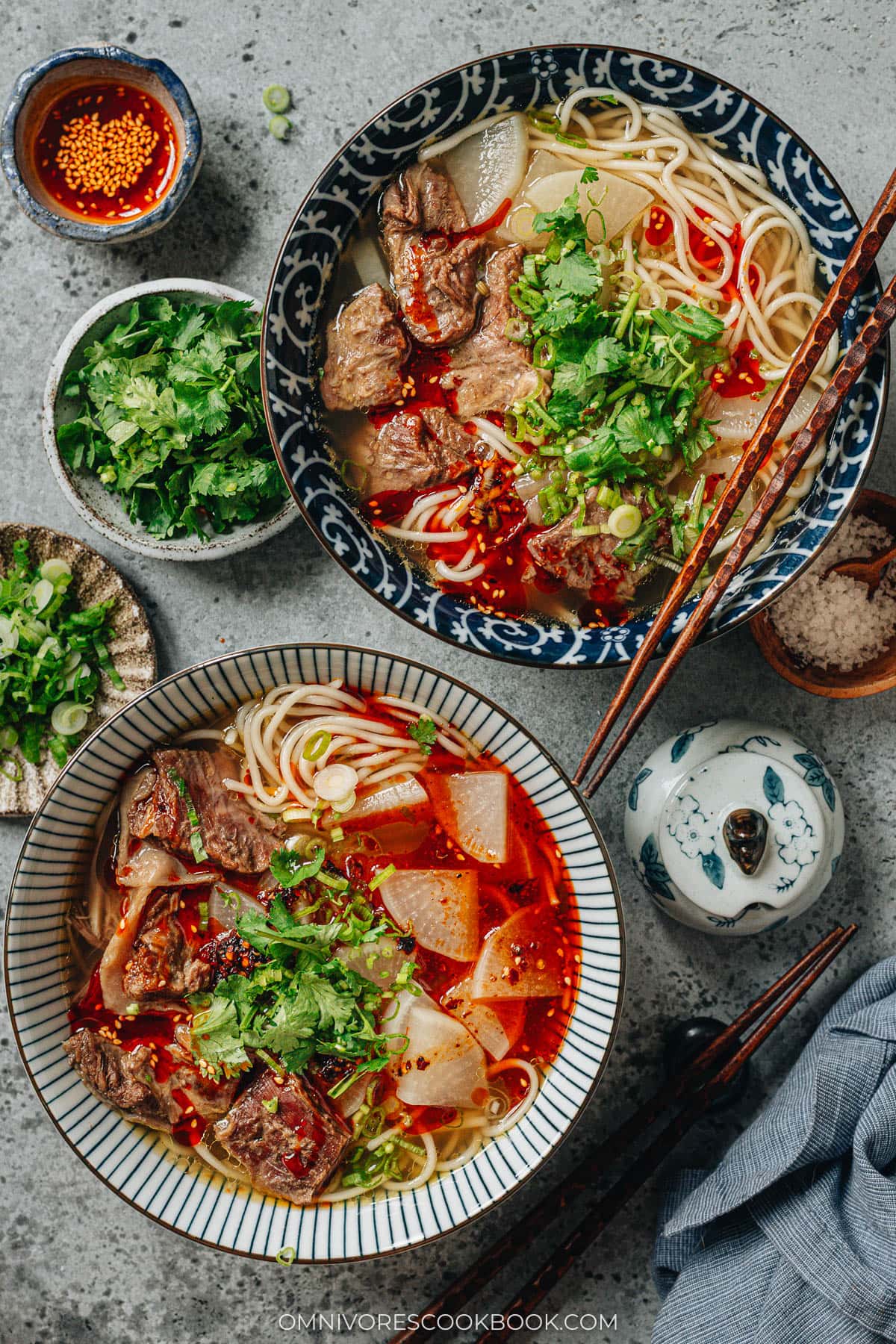
Frequently asked questions
Why do my noodles turn soft too quickly?
I cook the noodles right before serving and keep them separate from the broth until the last moment. When noodles sit in hot broth for too long, they soften quickly, so I always assemble the bowls just as I sit down to eat.
How do I know when the beef is ready?
I lift a piece from the pot and check if it is tender enough to cut with chopsticks. When the beef reaches that point, the broth usually carries a richer aroma, and everything harmonizes. It is a signal that the pot has done its work.
What is the best way to store this soup?
I usually place the broth and beef in airtight containers once they cool to room temperature, and they keep well in the fridge for about 4 days. When I freeze the broth, I leave a little space at the top of the container and it stays in good shape for up to three months. I freeze the cooked beef separately so it’s easier to portion out, and I always cook fresh noodles right before serving because they do not store well once mixed with the broth.
Chinese Cooking Made Easy
Are you new to this website? This free email series is a great place to start. I’ll walk you through a few of my most popular recipes and show you how and why they work. You’ll quickly start to cook better Chinese food in your own kitchen.
Watch video
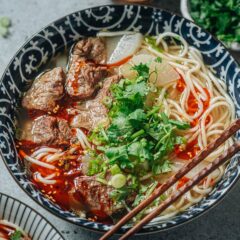
Lanzhou Beef Noodle Soup (兰州拉面)
Ingredients
- 2 to 3 lb beef shin bones (*see footnote 1)
- 2 lb untrimmed beef flank , or brisket, or round roast (*see footnote 2), cut into 3” (7 cm) pieces
- 2 Chinese scallions or 4 green onions, white part, cut to 4” (10 cm) pieces
- 1 thumb ginger , sliced
- 5 cloves garlic
- 5 Chinese dried chili peppers
- 5 whole cloves
- 2 bay leaves
- 1 teaspoon whole Sichuan peppercorn
- 1 teaspoon fennel seed
- 1 whole nutmeg
- 1 star anise
- 1 cinnamon stick
- 2 teaspoons salt (or to taste)
- 1 small daikon radish , peeled and sliced to 1/2” (5 mm) quarters
- 1.3 to 2 lbs fresh Lanzhou noodles (or 1 to 1.3 lb / 400 to 600 g dried wheat noodles)
Serving
- Homemade Chinese chili oil (for serving)
- Extra salt (for serving)
- Cilantro , chopped (for garnish)
- Green onion , sliced (for garnish)
Instructions
To cook the broth
- Add the beef bones and meat into a large pot. Add 8 cups of cold water. Heat over medium-high heat until brought to a boil. Stir occasionally to prevent the bottom from sticking. When it starts to boil, turn to medium heat. Skim the brown foam from the top and discard it. Boil and skim until the broth turns almost clear, 10 minutes or so.
- Transfer the meat and bones into the Instant Pot, and pour in all the broth. You can keep cooking on the stovetop if not using an Instant Pot. (*Footnote 3)
- (Optional) Add the cloves, Sichuan peppercorn and star anise into a tea infuser. Submerge the tea infuser in the broth.
- Add the scallion, ginger, garlic, dried chili pepper, bay leaves, fennel seed, nutmeg, cinnamon stick into the Instant Pot. Set the pressure on high, timer for 1 hour. Once done, let pressure release naturally. If you want to use fast release, do a natural release for at least 20 minutes first, to prevent it from spilling.
- Once done, remove and discard the spices, aromatics, and beef bones using a pair of tongs. You can also strain the broth if that is easier. But you need to pick out the meat separately.
- You might find a thick layer of oil floating on top of the soup (depending on the fattiness of the beef). Use a ladle to skim the oil off according to your preference (*footnote 4).
- Add salt and mix well. Taste the broth and adjust seasoning if needed. The broth should taste a bit salty by itself, so it will be perfect after adding the noodles. You can also adjust the seasoning later, after assembling the bowls.
- Turn on the saute function if using Instant Pot. Add the daikon radish and cook until tender, 10 minutes or so.
- Boil the noodles according to package instructions.
To assemble noodles
- Add noodles to each serving bowl, then pour in the broth. Top noodles with beef, a few pieces of daikon radish, and some cilantro. Serve immediately with chili oil and soy sauce on the side. Enjoy hot as a main dish.
Notes
- If the bones are not cut, ask the butcher to cut the beef bones lengthwise into short pieces when purchasing.
- Using untrimmed cuts will generate a very tender and moist lean part after simmering. You can trim off and discard the fat before serving. Other beef cuts such as brisket, shank, or round roast are also suitable for this recipe.
- Add 2 cups of water into the pot if you keep cooking on the stovetop. Cover and simmer over low heat for 3 hours, or until the beef turns very tender.
- I usually skim off as much oil as I can and save it. Some people like to serve the broth with oil on top, but I found it delicious enough without the oil. You can use the oil for stir-frying later and it will help you create very delicious dishes. To store beef fat, allow the oil to cool in a small bowl at room temperature, then transfer it to an air-tight container. It can be stored in the fridge for up to 2 weeks.
Nutrition

Did you make this recipe?
I’d love to hear how it turned out for you! Please take a moment to leave a 5-star rating ⭐️ and share your thoughts in the comments further down the page. It really helps others discover the recipe too.

Jennifer
I have a 5 qt instant pot. Do you recommend a larger size?
Maggie Zhu
A 5 qt instant pot will be perfect for this recipe!
MD
This was a great success at dinner last night. I have tried several of your recipes and they are always so easy to follow and create delicious results. The broth was so fragrant and I loved that a relatively cheap cut of meat was allowed to shine through what was a comforting, moreish meal. Thank you for sharing.
Pennie G.
I will have to try this in my Instant Pot. After living in Lanzhou for a year, I loved the soup. I have done it without an IP and it did take a “long minute” to make. Thanks so much for the recipe
Sabrina
Hi, I love your site and have made many of your amazing recipes! I’m curious – why do some of the spices get put in a tea infuser/spice bag while others float freely in the soup, when they all get removed? Do some of them diffuse differently? I’m super excited to try this out! I like adding greens to my soup when I can – bok choy or flat cabbage seem like they might be good in this soup. What do you think? Do you have any other suggestions for greens? Thanks so much!
Maggie Zhu
I used to use my mom’s tea infuser back in China (when I published this recipe) and use it in soup and stews so I can remove the small solid spices easily. I still have the tea infuser but sometimes I just forgot to use it lol Also, many people don’t have it so if a soup really need straining, I usually include that in the steps.
For the greens, bok choy and napa cabbage should work perfectly.
jobebe
Fabulous dish!
Michelle Sou
Hi Maggie!
Wondering how we can turn this into a instant pot recipe? Maybe brown the beef then pressure cook 45min?
Thanks
Victoria Murray
Can I use your Asian beef stock recipe for Lanzhou Beef Noodles recipe?
Maggie
Yes you can!
The Mrs
This is my regular go to when I need my noodle soup for comfort. For me, I only use the recipe for the broth and just add a store bought dried rice noodles instead. They don’t realize it, but my family are forever in your debt! Thanks so much for your website.
Tim
I disagree with the statement that only Lanzhou can make proper Lanzhou beef noodles. I’ve had great beef noodles throughout Gansu province, as well as in Xinjiang, Ningxia, Qinghai, and Shaanxi – You can get great hand-pulled beef noodles throughout the northwest, sometimes even better than those served in Lanzhou.
If you’re talking about places beyond the northwest, Beijing’s are okay but anywhere in the south is disappointing.
Alex
Hi,
In the recipe, you talk about covering the pot, but in your photos (and in other steps) it seems as though lots of water is boiling off.
Can you clarify whether the pot should be covered or left open?
Thanks! I’m cooking it right now so hopefully it goes okay 🙂
Maggie
Hi Alex, it has been a long time since I posted the recipe, so I’m trying my best to remember it.
I think you should cover the pot. Because the super long cooking time, the broth will reduce too much if you keep the lid open.
You can check on the broth after 3 hours of simmering. If the broth doesn’t taste rich enough, you could always leave the pot uncovered for the last 30 minutes to 1 hour of simmer to reduce it further.
Marley Cameron
Absolutely loved this recipe! It was a big hit in our house last night and will definitely be added to our rotation! Easy to follow, easy to make, easy to love! I also made the chili oil from your recipe and it made all the difference in our noodles!!!
I have a great photo if you’re interested in seeing how it turned out!!!
Maggie
Hi Marley, I’m glad to hear you like the recipe! Of course, would love to see your photos 🙂
Margaret
Maggie, can beef shortribs be used in place of flank steak
Maggie
Hi Margaret, yes! Beef short ribs totally work!
Pennie G
I lived in Lanzhou for 1 year . Lanzhou beef noodles are AMAZING and I miss it a lot. I have made it here in the States and it took all day but we’ll worth it. The recipe I have is very similar to yours.
J-Mom
It might have been OK for me to have tried this recipe first without reading all the details. I might have been intimidated.
I’m attracted to recipes that use star anise or Sichuan peppercorn. So I’ve been wanting to make this for a while. But every time I think about it, I don’t have the ingredients nor the 3~4 hour to cook.
But I finally did it! Although, since I couldn’t remember the recipe correctly I bought lamb instead of beef so to be technical, I didn’t make this 😉 Nevertheless I loved the results. Next time I will try the beef.
Thank you for the recipe!
Mark Cummings
Excellent recipe! I made your recipe this past weekend and it was amazing! Absolutely delicious! Well thought out and easy to follow! I have a question though. Due to time constraints, I’d love to prepare this a day or two before served to guests. I know your instructions say that the broth and the beef can be chilled, or frozen, separately in air tight containers. My question is, what to do with the radish that is placed in the broth 30 minutes prior to finishing the broth? Do I just cook that as well and refrigerate, then just heat it all back up before serving? Thanks again for an amazing dish!
Maggie
Hi Mark, thanks for taking time to leave a comment and I’m so glad to hear you like the dish! To answer your question, daikon radish holds together rather well so I wouldn’t mind cooking them ahead. What you can do is cook it 15 to 20 minutes prior to finishing the broth, so it won’t turn mushy while reheating. If you want the dish super fresh, you can also reheat the broth in a pot on the stove top and cook the radish right before serving the noodle soup. Hope this is helpful. Let me know if you have further questions 🙂